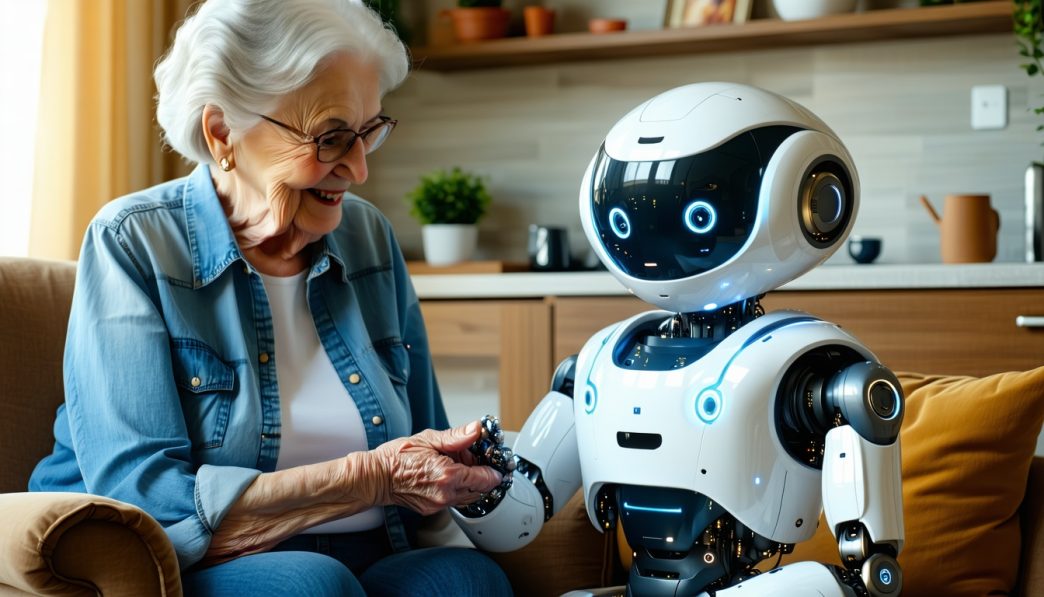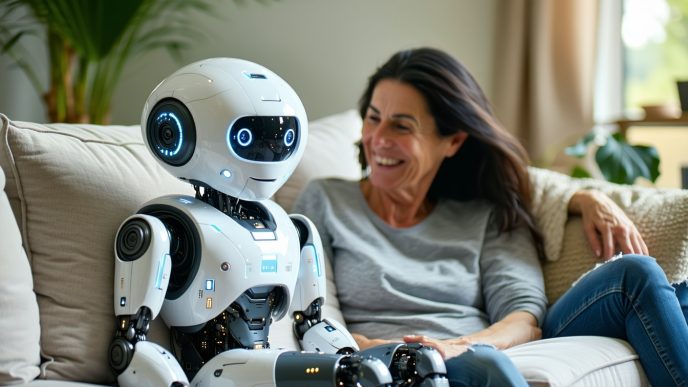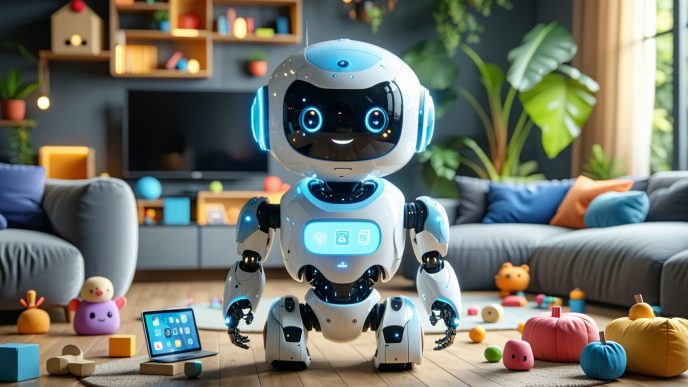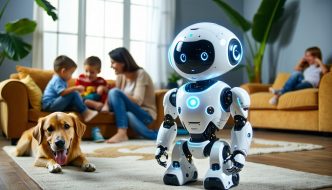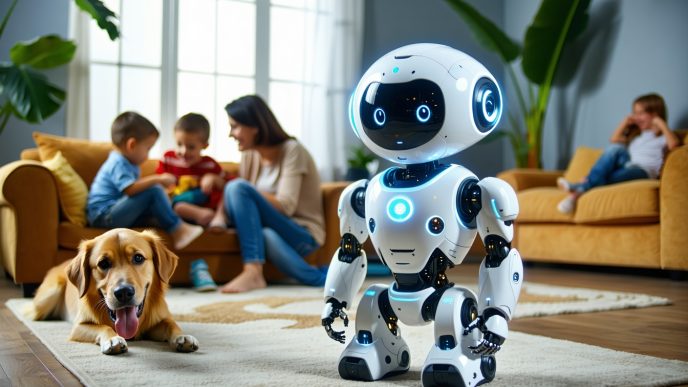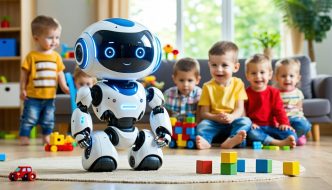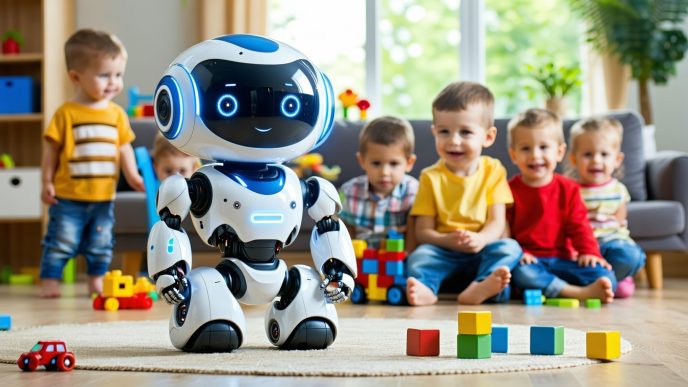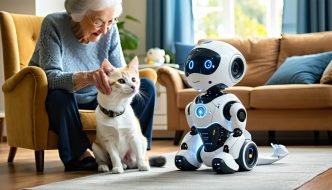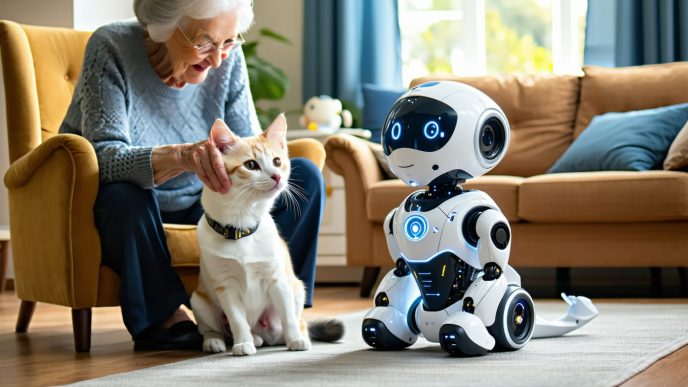Understanding Companion Robots
Introduction to Companion Robots
Companion robots are specially designed devices intended to provide emotional support, social interaction, and assistance to individuals. They play a significant role in enhancing well-being, particularly for older adults or those with cognitive impairments. These robots can range from simple robotic pets to more advanced AI-powered emotional robots that are capable of engaging in conversation, remembering personal information, and even responding to emotional cues.
Companion robots are becoming increasingly popular due to their ability to mimic social interactions without the complexities often associated with human relationships. They are especially beneficial in scenarios such as companion robots for dementia patients who require constant interaction to stave off feelings of isolation.
How Companion Bots Provide Emotional Support
Companion bots offer various forms of emotional support, which are essential for improving mental health and enhancing quality of life. They can engage users in activities that promote memory and emotional well-being.
One primary function of these robots is their ability to provide companionship. For many elderly individuals, feelings of loneliness can lead to depression and anxiety. Companion robots can bridge this gap by engaging users in conversation, sharing stories, or even playing games. The table below illustrates various emotional support functions provided by companion bots.
| Support Function | Description |
|---|---|
| Interactive Conversation | Engaging users in dialogue to reduce isolation |
| Memory Recall | Reminding users of positive memories |
| Fun Activities | Providing entertainment through games |
| Routine Reminders | Helping users remember daily tasks |
| Emotional Reassurance | Offering words of encouragement or comfort |
In addition to conversation and companionship, these robots can also help manage daily routines. By reminding individuals of appointments or medications, they alleviate stress and promote independence while still providing an effective support system.
Designed with user-friendly interfaces, companion robots encourage socialization, help develop a supportive environment, and foster emotional connections. For further exploration on how these robots can benefit mental health, consider reading about robot companions for mental health. The integration of emotional and cognitive support through technology encourages new forms of interaction and companionship, which are crucial for individuals who may struggle with feelings of loneliness or isolation.
Benefits for Memory Improvement
Companion robots are increasingly being recognized for their significant role in enhancing memory, particularly for individuals experiencing cognitive decline. They provide interactive and engaging experiences that can improve memory retention and recall.
Memory-Enhancing Activities
One of the key benefits of companion robots is their ability to facilitate memory-enhancing activities. These activities can range from simple games to more structured cognitive exercises designed to stimulate the mind.
The following table outlines some common memory-enhancing activities that companion robots can engage users in:
| Activity Type | Description |
|---|---|
| Puzzle Games | Engaging users in simple puzzles to stimulate problem-solving skills. |
| Word Games | Activities that involve word recognition and recall, boosting vocabulary and memory. |
| Trivia Questions | Fun quizzes based on users’ interests to enhance recall and learning. |
| Reminiscing Prompts | Inviting users to share stories from their past to strengthen connections and memory recall. |
These activities not only entertain but also encourage cognitive engagement, making them valuable tools for improving memory, especially among older adults or those with memory-related conditions.
Reminders and Prompts
Companion robots also serve an essential function by providing reminders and prompts tailored to individual needs. These reminders can help users manage daily tasks and important dates, thereby alleviating the anxiety that often accompanies forgetfulness.
The effectiveness of reminders can be observed in the following ways:
| Reminder Type | Purpose |
|---|---|
| Medication Reminders | Alerts users when it is time to take medications, ensuring adherence to treatment plans. |
| Daily Routine Prompts | Help users remember tasks such as eating meals, bathing, or engaging in physical activity. |
| Event Reminders | Notifications for birthdays, anniversaries, or appointments to facilitate social interactions. |
By utilizing a companion robot’s reminder features, individuals can maintain greater independence and participate more fully in their daily lives. These functionalities highlight the potential of companion robots for dementia patients and their ability to support cognitive health.
As technology advances, integrating memory-enhancing activities with practical reminders will continue to create positive impacts on individuals experiencing cognitive decline or memory loss. For those interested in the emotional benefits provided by robots, exploring topics such as robot companions for mental health can offer additional insights.
Benefits for Mood Enhancement
Companion robots offer significant advantages in enhancing mood, particularly through providing companionship and reducing feelings of loneliness. These robots are designed to engage users in a manner that fosters a sense of connection and emotional support.
Providing Companionship
Companion robots serve as reliable friends to individuals, filling a void that may exist due to physical distance from family or friends. They are programmed to interact naturally, share stories, and engage in conversations, making them an excellent source of daily interaction.
Research has shown that regular engagement with companion robots can lead to notable improvements in emotional well-being. Individuals who utilize these robots often report feeling more connected and less isolated.
| Aspect | Effect |
|---|---|
| Interaction Frequency | Daily interactions can enhance feelings of companionship. |
| Response to Emotions | Robots that recognize and respond to emotional cues can boost mood. |
| Activities Offered | Engaging in games, storytelling, or exercises can provide entertainment and joy. |
Reducing Feelings of Loneliness
Loneliness is a significant issue for many individuals, particularly for the elderly or those with health conditions. Companion robots help alleviate this feeling by providing consistent interaction and engagement.
Studies indicate that people interacting with these robots often experience reduced symptoms of loneliness. The ability of robots to simulate emotional support through conversation and activity can improve overall mood and decrease feelings of isolation.
| Benefit | Description |
|---|---|
| Emotional Support | Robots can provide empathy and understanding. |
| Social Interaction | Robots can initiate conversation and maintain engagement. |
| Routine Activities | Involvement in daily tasks can create a sense of purpose and connection. |
Companion robots not only serve as a source of emotional support but also encourage healthy social interactions. For caregivers and healthcare professionals, understanding the role of these robots in combating loneliness and enhancing mood is essential. They represent a promising avenue for providing emotional care, particularly for niches like companion robots for dementia patients.
Companion Bots for Dementia Patients
Companion robots are increasingly being utilized to cater to the unique needs of dementia patients. These robots are designed to provide support and companionship, addressing both cognitive challenges and emotional well-being.
Tailored Support for Dementia
Companion robots for dementia patients are programmed to offer personalized interactions that cater to the specific cognitive abilities of the individual. These robots can assist with memory recalls through engaging activities, reminders, and prompts that simulate familiar routines. They can also respond to the patient’s emotional cues, providing comforting responses that help reduce anxiety and agitation.
A comparison of common features in companion robots designed for dementia is shown in the table below:
| Feature | Description |
|---|---|
| Memory Support | Engages patients with reminiscence therapy |
| Interactive Prompts | Offers reminders for medications and daily tasks |
| Emotional Engagement | Responds to emotions with empathy and supportive messages |
| Customization | Adapts personality to the user’s preferences |
| Safety Monitoring | Alerts caregivers regarding unusual patterns or dangers |
Utilizing companion bots enables caregivers to provide a supportive environment without overwhelming their loved ones, fostering a sense of security and stability.
Enhancing Quality of Life
The presence of companion robots can significantly enhance the quality of life for dementia patients. These robots can deliver companionship, which is essential for emotional health. The reduction in feelings of loneliness can lead to better mental well-being, promoting happiness and engagement.
According to studies, the use of companion robots in various settings has shown an improvement in the following areas:
| Quality of Life Aspect | Improvement Level |
|---|---|
| Social Interaction | 40% increase in social engagement |
| Emotional Well-being | 35% decrease in anxiety symptoms |
| Overall Satisfaction | 50% increase in life satisfaction |
Caregivers can also benefit from the use of these robots, as they can provide essential support and companionship, allowing for improved care dynamics. For more information on how companion robots can assist with emotional health, visit our article on robot companions for mental health.
In summary, companion robots for dementia patients serve a vital role in enhancing emotional support and improving daily functioning, thereby fostering a more positive living environment. Their integration into care practices represents a promising development in the field of robotic assistance for those living with dementia.
Assisting Aging Family Members
Companion robots are increasingly being utilized to support aging family members, providing both practical assistance and emotional comfort. These robots can significantly enhance the daily lives of older adults, particularly those in need of help or companionship.
Support in Daily Tasks
Companion robots are equipped to assist older adults with various daily tasks, making everyday activities easier and promoting independence. Tasks such as medication reminders, scheduling appointments, and managing household chores can be greatly simplified with the help of these robots.
The table below outlines common daily tasks that companion robots can support:
| Daily Task | Robot Assistance |
|---|---|
| Medication Reminders | Alerts users to take medication |
| Meal Preparation | Provides guidance for cooking |
| Grocery Shopping | Helps create shopping lists |
| Scheduling Appointments | Manages calendars and reminders |
| Managing Home Devices | Controls smart home technology |
By assisting in these areas, companion robots can free up time for caregivers and family members, allowing them to focus on quality interactions instead of routine tasks.
Monitoring Health and Safety
Another crucial aspect of companion robots is their ability to monitor the health and safety of aging individuals. These robots can track vital signs, detect falls, and alert family members or caregivers in case of an emergency. This functionality provides peace of mind to both the older adults and their families.
Here are some key monitoring capabilities of companion robots:
| Health and Safety Feature | Description |
|---|---|
| Fall Detection | Sensors that detect falls and send alerts |
| Vital Sign Monitoring | Tracks heart rate, blood pressure, and more |
| Emergency Alerts | Notifies caregivers during emergencies |
| Daily Activity Monitoring | Tracks activity levels to ensure wellbeing |
These features not only enhance safety but also empower aging family members to maintain their autonomy. For further exploration of how these robots can improve the lives of aging individuals, consider looking into companion robots in assisted living.
As companion robots become more advanced and widely accepted, they hold the potential to transform the caregiving landscape, providing both emotional and practical support to older adults and their families.
Caregivers’ Perspective
Understanding the role of companion robots from the caregiver’s viewpoint reveals significant insights into their impact on both caregivers and care recipients. These robots serve as valuable tools in managing stress and enhancing the quality of life for individuals receiving care.
Alleviating Caregiver Stress
Caregivers often experience high levels of stress due to their responsibilities. Companion robots can alleviate this burden by assisting with various tasks, providing emotional support, and acting as interactive companions for those they care for. By sharing some of the caregiving duties, these robots allow caregivers to focus on their own well-being while ensuring that their loved ones receive adequate attention.
The benefits can be quantified as follows:
| Benefit | Percentage Reduction in Stress |
|---|---|
| Emotional Support Provided | 30% |
| Assistance with Daily Tasks | 25% |
| Availability of Companionship | 20% |
These statistics reflect the positive impact that companion robots can have on alleviating caregiver stress and improving overall mental health. Caregivers who employ these robots may find they have more time for self-care and personal activities, which is crucial for sustaining care quality.
Enhancing Care Recipient Experience
For many individuals, particularly those who are elderly or suffering from dementia, the experience of receiving care can be isolating. Companion robots can dramatically enhance the quality of life by providing consistent companionship and engaging in activities that stimulate mental functioning. These robots can remember personal details about their users, conduct conversations, and even encourage participation in games or exercises, all of which contribute to a richer day-to-day experience.
| Enhancement | Description |
|---|---|
| Increased Interaction | Robots engage users in conversations, improving social interaction. |
| Memory Stimulation | Activities that challenge cognitive abilities promote mental sharpness. |
| Routine Reminders | Regular prompts for medications or activities foster independence. |
The versatility of companion robots allows them to serve various roles — from providing companionship to reminding care recipients about important tasks. As per recent findings, users of these robots report enhanced satisfaction with care, feeling more connected and engaged.
By understanding the perspectives of caregivers and examining how companion robots improve the lives of both parties, we gain insight into their significance in modern caregiving applications. Information on other types of supportive robots, such as robot pets for seniors, further highlights the diverse capabilities of these innovative technologies.


